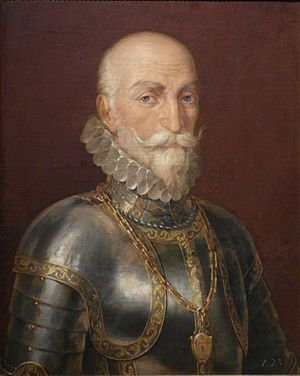Álvaro de Bazán, 1st Marquess of Santa Cruz facts for kids
Quick facts for kids
The Most Excellent
The Marquess of Santa Cruz
|
|
|---|---|
 |
|
| Born | 12 December 1526 Granada, Spain |
| Died | 9 February 1588 (aged 61) Lisbon, Portugal |
| Buried |
Viso del Marqués
|
| Allegiance | |
| Service/ |
Spanish Navy |
| Years of service | 1544–1588 |
| Rank | Captain General of the Sea General Admiral |
| Battles/wars | Battle of Muros Bay Siege of Malta Battle of Lepanto Battle of Ponta Delgada Conquest of the Azores Drake's 1587 expedition, (there was no direct combat) |
| Awards | Marquess of Santa Cruz Order of Santiago |
Álvaro de Bazán, 1st Marquess of Santa Cruz (born December 12, 1526 – died February 9, 1588), was a famous Spanish admiral. He was known for never losing a battle in his 50-year career! His special warship, called La Loba (The She-Wolf), had a golden wolf figure on its front. This ship was feared by Spain's enemies and brought hope to Spanish sailors.
Contents
Álvaro de Bazán was born in Granada, a city in southern Spain. He came from a family of brave military leaders. His grandfather helped conquer Granada in 1492. His father, Álvaro de Bazán the Elder, was also a naval commander. He served Emperor Charles V and helped recapture Tunis in 1535. His father became the main commander of Spain's warships, called galleys, in the Mediterranean Sea.
Álvaro followed in his father's footsteps from a young age. He quickly rose through the ranks of the Spanish navy. When he was just eight years old, he was named "Military Governor and captain of the fortress and city of Gibraltar". However, his father was truly in charge of Gibraltar's defenses. Álvaro was also a member of the Order of Santiago, a famous military order.
Early Victories
In 1564, Álvaro de Bazán helped capture Peñón de Vélez de la Gomera. He also led a group of galleys to stop piracy from the port of Tétouan. He did a great job, earning the trust of King Philip II. In 1568, King Philip II put him in charge of the galleys in Naples. This role brought him close to John of Austria. They worked together when the Holy League was formed against the Turks in 1570.
The Battle of Lepanto
Álvaro de Bazán played a key role in the famous Battle of Lepanto on October 7, 1571. He always pushed for the most daring plans. In the battle, he commanded the reserve fleet. His quick actions saved the day when the Turkish commander, Uluj Ali, outsmarted the Christian right wing. Álvaro's swift response prevented a disaster and helped the Holy League win. The next year, he joined Don John of Austria in taking Tunis.
Conquering the Azores
In 1580–1581, King Philip II of Spain claimed the throne of Portugal. But António, a member of the old Portuguese royal family, resisted. He held onto the Azores islands with help from French adventurers. Santa Cruz was sent as "Admiral of the Ocean" to remove António and his allies in 1582.
Even though he was greatly outnumbered, Santa Cruz won the Battle of Ponta Delgada. This battle took place off Terceira Island against a mix of Portuguese, French, English, and Dutch ships. His victory secured the Azores for Spain.
Planning the Spanish Armada
Santa Cruz understood that England was a big threat to Spain's empire. He strongly believed Spain should go to war with England. In a letter to King Philip from Angra do Heroísmo in Terceira on August 9, 1583, he first suggested the idea of the Spanish Armada. This was a huge fleet meant to invade England.
Santa Cruz was supposed to lead the Armada himself. He spent a lot of time planning and estimating what was needed. However, King Philip was slow to make decisions and faced many money problems. This caused many delays. While Santa Cruz was in Lisbon, trying to get his fleet ready, Francis Drake attacked and burned Spanish ships in Cádiz in 1587.
Santa Cruz was very independent in his thinking, which sometimes annoyed the king. He was unfairly blamed for delays and problems that were not his fault. He died on February 9, 1588, in Lisbon. Some say the king's unfair criticisms made him sicker.
Santa Cruz also helped create the large galleon ships that carried goods between Cádiz in Spain and Vera Cruz in Mexico.
Legacy of Álvaro de Bazán

Álvaro de Bazán is remembered as one of Spain's greatest naval heroes. Many documents about the Spanish Armada mention his plans and ideas.
Several ships of the Spanish Navy have been named Álvaro de Bazán in his honor. Today, a new type of warship, the Álvaro de Bazán class frigates, is being built for the Spanish Navy. The first ship in this class is the Álvaro de Bazán (F101).
He was also featured on the 1953 1 Peseta banknote, showing his importance in Spanish history.
Images for kids
-
Depiction of the Battle of Lepanto by Tintoretto
See also
 In Spanish: Álvaro de Bazán para niños
In Spanish: Álvaro de Bazán para niños



